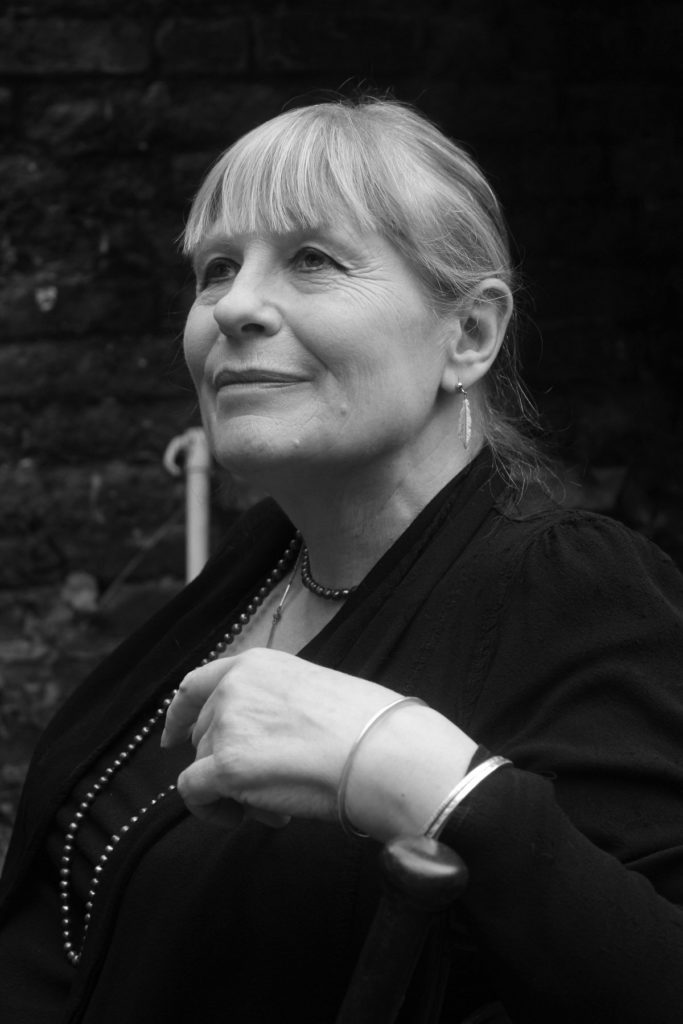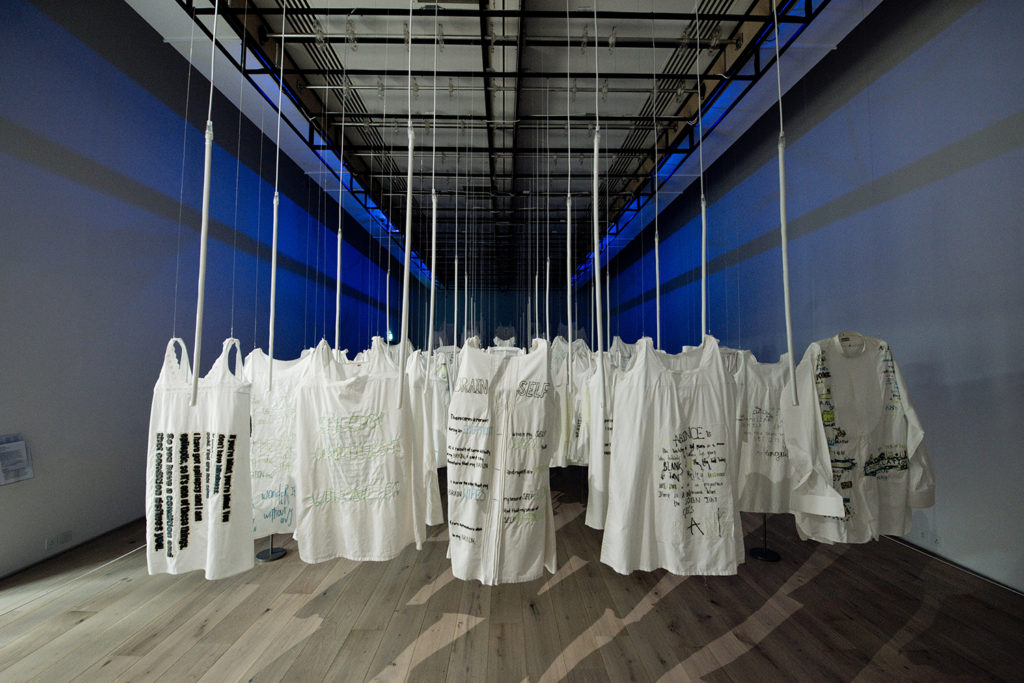A degree in philosophy and an encounter with scientists and doctors treating her for a suspected brain hemorrhage made Susan Aldworth the interdisciplinary artist that she is today.
“That incident let me look at my own brain working in real-time on a monitor and gave me this sense of embodiment. After I had recovered, I sat in on people’s brain scans in the hospital (with permission, of course) to contemplate and draw the relationship between the physical brain and the mind,” says Aldworth.
Aldworth is a visual artist who works and resides in London. An experimental printmaker and filmmaker, she studied philosophy at Nottingham University and fine art at Sir John Cass, London. She is also an associate lecturer in the Art & Science MA at Central Saint Martin’s, London.

Susan Aldworth – Visual Artist
“It’s an interesting sort of specialisation,” says Aldworth, and she always tells her students “to focus on what they are interested in… take the risk and time it takes to become an artist.” She believes it is essential to not be too respectful of either field; to question what needs to be questioned.
“Keep your questions big.” – Aldworth

Elisabeth, Susan Aldworth, installation of 9 monotypes with chine-collé, 2.5x2m, shown at National Portrait Gallery, London 2013. Image courtesy of NPG.
Aldworth, as a dynamic artist interested in science, is highly intrigued by the workings of the human mind. She constantly aims to explore topics such as sleep, consciousness, and our sense of self.
But what is it about the brain that fascinates Aldworth so much?
“It is very simple really. The brain is just a piece of flesh, but how on earth does consciousness emanate from it? How does it turn matter into imagination? How does my sense of self and personality emerge from this physical organ of the body?” says Aldworth. “I think my love of the brain has a lot do with my interest in philosophy and the fact that neuroscience can look into this piece of flesh and start to offer answers to big philosophical questions,” she continues.
According to Aldworth, brain scans are a new material for artists to work with – prior to them the only way to see a brain was via dissection. She often uses them in her art. “Brain scans are beautiful – they look like trees! And although these scans are just anatomical, they seem to signpost interiority, the person within, and this has a sort of potency in contemporary culture,” says Aldworth.
Her award-winning exhibition, ‘The Dark Self’ (2017), was inspired by research on sleep during her three-year residency at the University of York. In ‘The Dark Self’, Aldworth explores the various aspects of sleep and its impact on the human condition. “Sleep is something unknown and invisible, and also individual: it’s my sleep and your sleep. As a visual artist, it was difficult to work with these [characteristics].”
“And although these scans are just anatomical, they seem to signpost interiority, the person within, and this has a sort of potency in contemporary culture.”
Aldworth worked with a neuroscientist and a sleep disorder clinic to explore the many narratives of sleep and sleep disorders. Using the pillow as the central motif for her exhibition in a medieval church, Aldworth asked four hundred people to embroider their sleep experiences and dreams onto pillowcases.
“The embroidered pillowcases were hung from the ceiling of the church like a silent congregation; I wanted people to think about the fact that everyone has to sleep,” Aldworth said.
With this exhibition, Aldworth aimed to diminish the notion that sleep is “nothing time” and that we don’t achieve much when we sleep. “We spend a third of our lives asleep and the science of sleep has become very important in modern medicine. Scientists have shown that our brains are as active when we sleep as when we are awake. But no-one can give an explanation of why we sleep,” she explains.
The pillow is the centre-piece in this exhibition, as a visual metaphor for sleeping, and it is a recurring motif as “the only evidence of sleep is the indent of the head on the pillow,” says Aldworth. Sculptures made from porcelain present the indentation of a sleeper’s head, a hard unyielding material that contrasts with the soft and giving quality of a pillow. “The sleeper is absent; the indentation is a negative space; and the work begins a dialogue about the unconscious state of deep sleep.”
Aldworth is also one of the artists in residency on the multidisciplinary project, CANDO (Controlling Abnormal Network Dynamics using Optogenetics). She and science artist Andrew Carnie have collaborated with the CANDO scientists in its public engagement project, ‘Illuminating the Self’.

1001 Nights, installation of embroidered pillowcases, Susan Aldworth. Shown in The Dark Self, York St Mary’s, 2017. Photograph by James Hardisty.
CANDO is a project to develop a cortical implant for neural control, with the final goal being creating the first-in-human trials in patients with focal epilepsy. Epilepsy affects almost 600,000 people in the UK and uncontrolled seizures have the potential to have devastating effects on patients.
“For my installation Out of the Blue, I spoke to almost fifty people with epilepsy to listen to their personal stories about living with epilepsy,” explains Aldworth. These participants wrote their extremely moving testimonies for Aldworth, who in turn collaborated with embroiderers who stitched the narratives onto 100 pieces of Victorian undergarments for display in the gallery. “I used Victorian underwear because like epilepsy, these garments were worn concealed beneath the surface; in their vintage, too, their very fabric would contain hidden histories.”
The stories were sewed onto the undergarments with UV sensitive thread and were highlighted intermittently with UV light. These 100 embroidered garments were suspended from the ceiling of Newcastle’s Hatton Gallery and moved on pulleys programmed by computers to correspond to the algorithms of electrical activity in an epileptic brain to correspond to the algorithms of electrical activity in an epileptic brain.

Out of the Blue, installation of 106 items of embroidered underwear, Susan Aldworth, 2020. Photograph by Colin Davison at Hatton Gallery, 2020.
However, COVID-19 thwarted the exhibition and before Aldworth knew it, it was taken down from the Hatton Gallery in Newcastle, after having been on display for a mere 6 weeks. “The project spanned almost 3 years and it was absolutely amazing. I was heartbroken it closed so soon, but we will find another venue to show it again,” says Aldworth.
Aldworth has two projects lined up for after the pandemic – while one focuses on the brain once again, the other explores human value. “I’ve been talking to a person who fell off her bike and hit her head, about the concussion she suffered; I think a lot of people get concussions, but we need to talk about it more openly and understand it better. The second project is about how we treat each other and how we value each other which I feel has been highlighted during the COVID-19 pandemic.” With all the chemical and physical elements in place, it would take us about £96,000 to build a human from scratch, and Aldworth believes that that’s a good place to start. “I want to talk to scientists, economists, politicians, ordinary people; everyone really, to get an idea of how we value one another. I don’t want to jump to any conclusions with this project, I just want to make a provocative piece,” explains Aldworth.
“It [art-science] is the most wonderful intellectual journey one could possibly go on.”
The amalgamation of art and science, according to Aldworth, is crucial to knowledge and its progress. The two fields, that appear to be so disparate, use varied methodologies but are equally rigorous. For longer than we can possibly recount, both fields have had great people who have made great leaps in knowledge, and Aldworth believes it is only natural to keep the trend going. Science is ever-changing – “21st-century science is so vastly different from 17th-century science” – and art is the best way to continuously question everything and help science move forward.
Aldworth’s life and career as an interdisciplinary artist have been beyond fruitful, and over the years, she has garnered the most incredible experiences and worked with a plethora of fascinating people. “It is the most wonderful intellectual journey one could possibly go on.”




